Paris or Bust: The Great New York-to-Paris Auto Race of 1908
Even before there were roads, there were men who wanted to drive fast
/https://tf-cmsv2-smithsonianmag-media.s3.amazonaws.com/filer/20120307040109Crowd-NYC1-500x330.jpg)
Nascar is a multibillion-dollar business whose history and rich mythology are rooted in money; Southern liquor-runners and moonshiners gave the earliest, postwar version of the sport much of its tone. But long before the advent of stock-car racing, competitive drivers cared less about prize or profit than about simply completing the course. The men who lined up in the swirling snow of Times Square on the morning of February 12, 1908, were embarking on a nearly unimaginable feat: a race from New York to Paris, westward. The contest was sponsored not by Bank of America or Coors Light, but by the French newspaper Le Matin and the New York Times. The prize: a 1,400-pound trophy and proving it could be done.
The proposed route would take the drivers across the United States, including through areas with very few paved roads, and then head north through Canada. Next came a left turn at Alaska, which the drivers had to cross in order to arrive at the Bering Strait, which separated the American wilderness from the Russian one. The race’s organizers started it in the middle of winter in the hope that the strait would be frozen. The course then led through Siberia, which no one had traveled by car, before heading into the final stretch: Moscow, St. Petersburg, Berlin and Paris—overall, a 22,000-mile trek in an age when the horse was considered more reliable than the horseless carriage. The New York-to-Paris race was suppoed to be (and is still largely considered) the greatest of them all, even surpassing the prior year’s Peking-to-Paris competition, in which the winner, Italian Prince Scipione Borghese, enlisted donkeys and mules to pull his car and sipped oily water from its radiator to relieve his thirst. His reward was a magnum of champagne.
In Times Square that morning 17 men, including drivers, mechanics and journalists, crammed into six cars from four countries: three from France, and one each from Germany, Italy and the United States. A quarter of a million people lined Broadway up to northernmost Harlem; those who couldn’t glimpse the cars had to settle for the whiff of gasoline and the strains of a brass band. The American entry, a 60-horsepower touring car called the Thomas Flyer, carried three extra gasoline tanks with a capacity of 125 gallons and primitive canvas convertible top. The race was scheduled to begin at 11 a.m., when Mayor George B. McClellan Jr., son of the Union Civil War general, planned to fire the starting pistol, but he was characteristically late. At a quarter-past, railroad financier Colgate Hoyt snatched the golden gun from the table and shot it into the air.
The contestants represented an international roster of personalities. G. Bourcier de St. Chaffray, driving the French De Dion, once organized a motorboat race from Marseille to Algiers that resulted in every single boat sinking in the Mediterranean. His captain was Hans Hendrick Hansen, a swashbuckling Norwegian who claimed to have sailed a Viking ship, solo, to the North Pole. He declared that he and his companions would reach Paris or “our bodies will be found inside the car.” Frenchman Charles Godard, driving the Moto-Bloc, participated in the Peking-to-Paris race without having driven a car and set an endurance record by driving singlehandedly for 24 hours nonstop.
Emilio Sirtori, the driver for the Italian Zust, took with him 21-year-old journalist and poet Antonio Scarfoglio, who had threatened to pilot a motorboat across the Atlantic if his father didn’t let him enter the race. (His father, a prominent newspaper editor in Naples, relented.) The German entrant, driving the Protos, was an aristocratic army officer named Hans Koeppen who regarded the race as an opportunity to raise his rank from lieutenant to captain. Montague “Monty” Roberts, manning the Thomas Flyer, was a gregarious crowd favorite and one of few American drivers who actually trained for races. His teammate was George Schuster, a 35-year-old mechanic for the E. R. Thomas Motor Company in Buffalo, New York. One of 21 children born to Casper Schuster, a German immigrant who worked as a blacksmith, George was an expert radiator solderer, chassis inspector, motor tuner and test driver. To Roberts, he was an ideal choice—high enough in the factory hierarchy to be considered indispensable, but too low to steal attention from Roberts himself. After the starting shot, the cars moved forward, Scarfoglio wrote, “between two thick hedges of extended hands amidst a roar as of a falling torrent.” The poet blew a kiss to the crowd, and they were off.
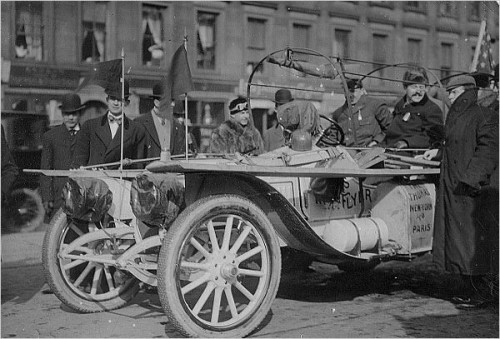
The American team was headed by Monty Roberts and George Schuster, in the Thomas Flyer. From www.sportscardigest.com.
August Pons, driver of the French Sizaire-Naudin, drpopped out after only 96 miles with a broken differential. The De Dion, the Zust and the Thomas Flyer quickly emerged as the leaders, with the Protos and the Moto-Bloc bringing up the rear. In Hudson, New York, the cars plowed through foot-deep snow in a single file. Schuster circled the Thomas Flyer—which had no heater or windshield—with a stick to check snow depth and put down planks for traction. The trail out of Auburn, which the New York Times described as the worst road in the United States, lived up to its reputation, with the three leading cars getting mired at Dismal Hollow in the Montezuma Swamp. The men prepared to camp for the night, but an American guide hired by the Italians came with six horses to pull the cars through.
They settled into a routine, rising at 5 a.m. and driving until 8 p.m., with the mechanics tinkering with the cars until midnight to repair cracks in the chassis and drain the radiators to keep them from freezing. (At the time, antifreeze was primarily used to produce explosives.) They stopped at hardware stores to fill up on gasoline, one bucketful at a time. The teams forged a tense agreement that they would alternate leadership every five hours, but this spirit of cooperation quickly dissolved. They convinced themselves that an hour or two would make a difference in a six-month race, and feared that their opponents would sneak off in the middle of the night. St. Chaffray took to giving imperious orders: “When you wish to go into a city ahead, you ask me,” he told Roberts. The American replied, “From now on you will know this is a race.”
The animosity increased as they trekked through the snow-battered Midwest, with the Italians accusing the Americans of cheating by using railroad tracks and the aid of a trolley car. A few of the foreign competitors took offense at the locals, whom they perceived as boorish. Scarfoglio sent off a snide dispatch: “I do not like the Americans as a whole, just as I do not like the cheesemonger whom a prize in a lottery or a sudden rise in the price of potatoes has made wealthy. There is still too much of the herdsman about them.” In Indiana, the Moto-Bloc and Protos teams resented the fact that they had to pay significant sums for the aid of horses and men while the Thomas Flyer was swarmed by Hoosiers anxious to volunteer. They sent a plea to the president of the Chicago Automobile Club, which the Tribune printed under the headline, “FOREIGNERS’ PATHETIC APPEAL”: “We are discouraged,” the note began. “The peasants demand $3 per mile for helping us…they charged $5 each to permit us to sleep on the ground. Peasants along the way have filled up road dug by leading cars, so as to help the Thomas car…would it be possible to influence public opinion to aid us?”
By March 8, the Thomas Flyer was leading in Julesburg, Colorado, and traveling with a new passenger: Hans Hendrick Hansen. The Norwegian had quit St. Chaffray’s team after the De Dion got stuck in a particularly bad snowdrift; when Hansen, the Artic expert, failed to extricate it, he and the Frenchman began to argue. They agreed to settle the matter with a duel, but before they could find their pistols St. Chaffray made an executive (and cool-headed) decision to fire Hansen. “I could go afoot over the Siberian route and beat the De Dion car,” Hansen retorted, and pledged his allegiance to the American flag.
Meanwhile, the Zust was in Omaha, the De Dion in Cedar Rapids, Iowa, the Moto-Bloc in Maple Park, Illinois, and the Protos a bit behind in Geneva, Illinois. As the Thomas Flyer approached frenzied crowds in Cheyenne, Wyoming, Monty Roberts knew that his time in the great race was nearing its end. He wanted to sail to Paris in May and race in the Grand Prix. E. Linn Mathewson, the son of the general agent for Thomas cars in the Midwest, would drive the Flyer through Wyoming to Utah. Professional driver Harold Brinker, famous for surviving a crash the previous year that had killed another driver, would take command in Ogden. George Schuster, the indefatigable mechanic, would drive through Alaska and Siberia, and Roberts would return when the car neared Europe.
Before leaving Cheyenne, Schuster bought a .38-caliber Colt with a six-inch barrel, reasoning it might come in handy. He continued to sacrifice himself for the journey when no one else could or would, walking ten miles in the dead of night to find gasoline and navigating the car out of gullies they couldn’t avoid. His acumen had kept the car running through blizzards, freezing temperatures and sandstorms. At each overnight stop, he repaired the fresh damage and readied the Flyer for the next leg of the journey. And he was so unheralded that newspaper reports frequently misspelled his name when they bothered to mention him at all.
By the time the Americans left Wyoming, they were leading by two states. The Italians were starting across Nebraska from Omaha. St. Chaffray was in Iowa, awaiting parts for the De Dion, while Lieutenant Koeppen in the Protos and Charles Godard in the Moto-Bloc were just entering Iowa. The Moto-Bloc was having mechanical trouble, although Godard was loath to disclose specifics. Desperate, he decided—in violation of the rules—to ship his car to San Francisco by railroad, but abandoned the idea when a photographer caught him in the act. Godard received a cable from the owners of his car: “Quit race, sell car and come home.” The Moto-Bloc was finished, leaving only four cars.
Harold Brinker drove the Thomas Flyer from Utah through Nevada and around the border of Death Valley, arriving in San Francisco the third week of March, 900 miles ahead of his closest competitor, the Zust. Factory whistles sounded and automobile drivers blew their horns on Market Street. “The record of the Thomas car from New York to San Francisco was a remarkable feat,” the New York Times concluded. “Many skeptics declared when the New York to Paris racers started out from New York in the dead of winter that none of them would get across Wyoming until summer, some that they would not reach Chicago and a few that they could not cross New York State.” The Americans prepared to ship the Flyer on a freighter to Seattle. After a two-day trip there, it would be transferred to a cargo ship headed for Valdez, Alaska. Brinker begged Schuster to let him to continue with the team, even as an assistant, but the mechanic refused. It was finally his car and his turn.
On Wednesday, April 8, the Flyer touched Alaskan soil. The welcoming committee consisted of the entire population of Valdez, few of whom had ever seen a car. Schuster wasted no time investigating the Valdez-Fairbanks Trail in a single-horse sleigh, and concluded that the only way to cross Alaska in a car would be to dismantle it and ship the parts by dogsled. The Parisian race committee abandoned the idea of Alaska and the Bering Strait and directed the Americans to return to Seattle. Their new plan called for the cars to sail to Vladivostok and drive to Paris from there. While the Americans were still at sea, their competitors, including the ever-troubled Protos, arrived in Seattle and set sail for Russia. Then the Americans lost time getting their Russian visas in order. The Flyer had been the first to arrive on the Pacific coast but was now the last to leave, a few weeks behind the competition.
The Italian and French teams were forging across Japan when the race committee made another decision. In recognition of the time the Flyer lost detouring through Alaska, the American team was given an allowance of 15 days—which meant, essentially, that the Zust and the De Dion could beat the Flyer into Paris by two weeks and still lose. The Protos, meanwhile, would be penalized 15 days for resorting to the train from Ogden to Seattle; the committee didn’t disqualify Lieutenant Koeppen entirely, concluding that there had been some honest confusion (unlike in Godard’s case) about the rules.
In Russia, the racers were advised to give up and take the Trans-Siberian Railway. Scarfoglio reported that the “great men of the Russian government, all covered with gold lace,” outlined the many reasons the venture would fail: “We shall be met on the road by Chinese brigands, Manchurian tigers, fever, plague, pestilence, famine—to say nothing of the mud after three months of rain, mosquitoes as big as locusts and other similar delights.” The drivers agreed to start again evenly matched. With one day to prepare, George Schuster searched for a supply of gasoline, which was scarce in Siberia. Back at his hotel, he received a note summoning him to St. Chaffray’s room. When he arrived he saw that the Italian team was already there.
“There is no petrol,” the Frenchman announced. “There are no means of getting any. What there was is in my possession, and I offer it to the car which will agree to take me onboard.” The Italians left the room in disgust. St. Chaffray tried to reason with the Americans, stating that he could get a seat on the German car, but the Flyer was sure to beat the Protos into Paris and he wished to be on the first car to arrive. He added that “it would not look well for a Frenchman to ride on a German machine.” Schuster calmly said he’d think about it, but he was seething. Privately he told his team that he’d rather stay in Vladivostok for the rest of his life than accept St. Chaffray’s bribe. Without fanfare, St. Chaffray transferred the rights to his gasoline to the Italian team, but was not allowed to join. His sponsor, the Marquis Jules-Albert de Dion, had decided he was finished.
In Perm, Russia, Schuster received a telegram from the Thomas factory in Buffalo: “Do you want us to send Montague Roberts to help you when you get on the good roads of Europe?” Schuster was so mad he could’ve “eaten nails,” as he put it, and sent an immediate reply: “July 9: Arrived today. Expect to reach Paris on July 24. Schuster.” The suggestion that he was good enough to drive the Flyer through the bogs of Siberia but not through the capitals of Europe impelled him, despite deadened nerves and aching limbs. He was now only a day ahead of the Protos and determined to maintain his lead.
There was one problem: Schuster kept getting lost. The Russians couldn’t understand hand signals and the Americans couldn’t understand Russian. One wrong turn cost the Americans 15 hours. Worse, the Flyer sunk into a mudhole and needed a day’s worth of repairs. Schuster heard that Lieutenant Koeppen had left St. Petersburg the same day and was on his way to securing a three-day lead. The Italians remained 3,000 miles behind, in Atchunsk.
At 6:15 p.m. on Sunday, July 26, five and a half months and 21,933 miles from the start in Times Square, Lieutenant Koeppen arrived in Paris, slowly guiding the Protos down Boulevard Poissonniere. A delegation of editors from Le Matin greeted him with tepid enthusiasm and served a cold buffet at his reception. At the same time, Schuster was having breakfast at the Imperial Automobile Club of Berlin, where several people congratulated him on his good showing. He didn’t bother to explain that the Protos would ultimately be docked two weeks for using the train in the American west, and that the Flyer was allotted two extra weeks for attempting the trip to Alaska. Schuster had a month in which to get to Paris and still win the race.
Schuster and his crew arrived on July 30, the Flyer making its way through the lines of lighted cafes, the crowds shouting wildly: “Vive le car Americain!” They cruised toward the Place de l’Opéra, where, in front of the Café de la Paiz, a gendarme stopped the car.
“You are under arrest,” he declared. “You have no lights on your car.”
A crowd of Americans rushed from the café and tried to explain, but the officer waved them away. The law was the law: a car had to have a headlight to be on the streets of Paris at night, or the driver was to be placed under arrest. A quick-thinking man on a bicycle rode up to the car, jumped off and deposited his bike, which had a headlight, in the Flyer next to Schuster. Problem solved. The gendarme stepped aside.
Schuster graciously insisted that Monty Roberts be present for the Flyer’s triumphant return to Times Square on August 17, 1908. After the accolades and parties died down, he returned to his job at the Thomas factory, where he was promised employment as long as the company was in business. Five years later, the Thomas company collapsed and all its goods were auctioned off. Lot number 1829 was listed simply as the “Famous New York to Paris Racer.”
Sources:
Books: Julie M. Fenster, Race of the Century: The Heroic True Story of the 1908 New York to Paris Auto Race. New York: Crown, 2005; Dermot Cole: Hard Driving: The 1908 Auto Race from New York to Paris. New York: Paragon House, 1991. Allen Andrews: The Mad Motorists: The Great Peking to Paris Race of ’07. Philadelphia and New York: J.B. Lippincott Company, 1965.
Articles: “Macedonian Cry for Help from Foreign Autoists.” Chicago Tribune, March 1, 1908; “First in Chicago Autos’ Aim.” Chicago Tribune, February 23, 1908; “New York to Paris the Hard Way, 100 Years Ago.” New York Times, February 10, 2008; “Race to Paris Starts Today.” New York Times, February 12, 1908; “The Greatest Race—1908 New York to Paris,” by Art Evans. Sports Car Digest, September 28, 2011: http://www.sportscardigest.com/the-greatest-race-1908-new-york-to-paris/; “Tour of Autoists Like Polar Trip.” Chicago Tribune, February 25, 1908; “Mathewson At Wheel of Racer.” San Francisco Chronicle, March 12, 1908; “American Car Will Try to Cross Alaska.” San Francisco Chronicle, March 27, 1908; “Thomas, Winner, Reaches Paris.” New York Times, July 31, 1908.
/https://tf-cmsv2-smithsonianmag-media.s3.amazonaws.com/accounts/headshot/karen.png)
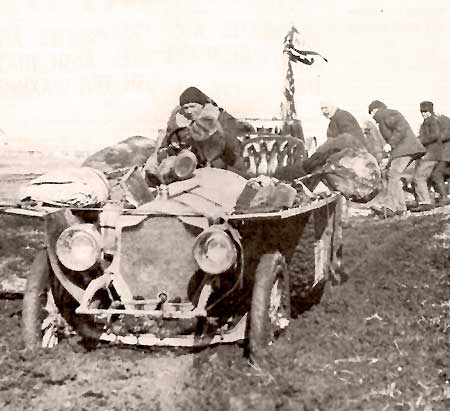
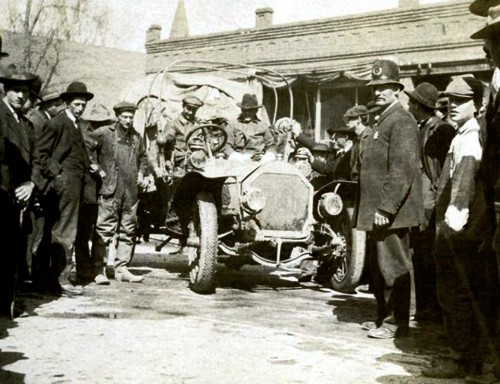
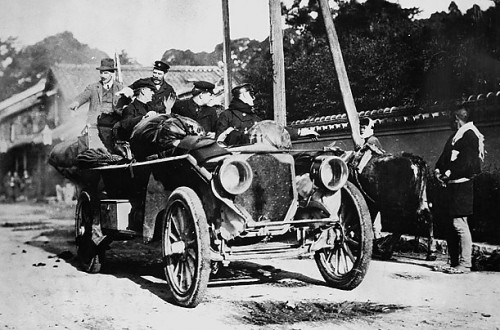
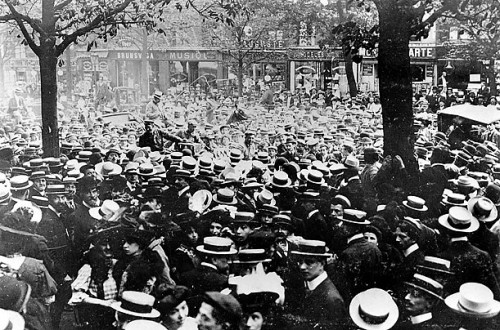
/https://tf-cmsv2-smithsonianmag-media.s3.amazonaws.com/accounts/headshot/karen.png)